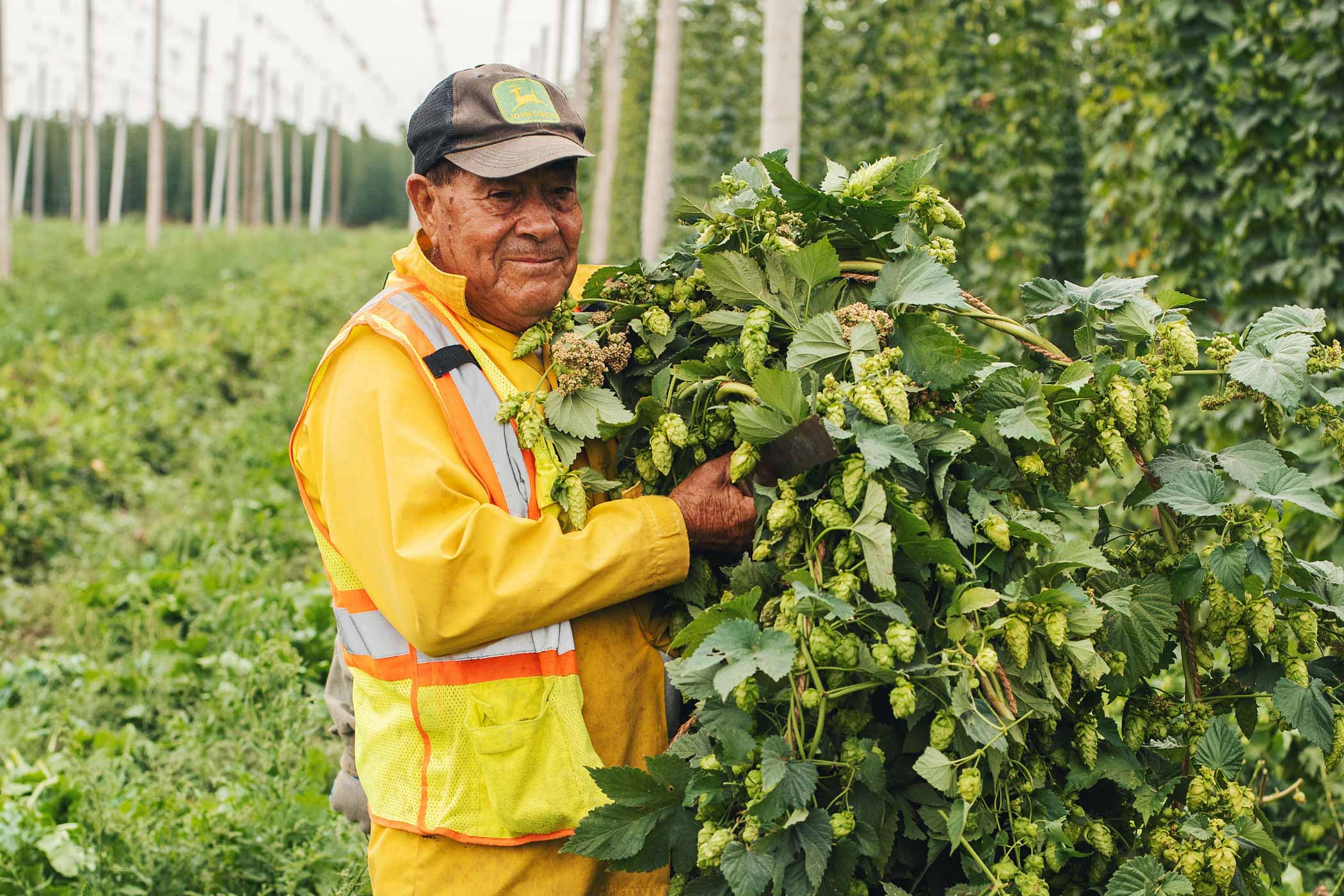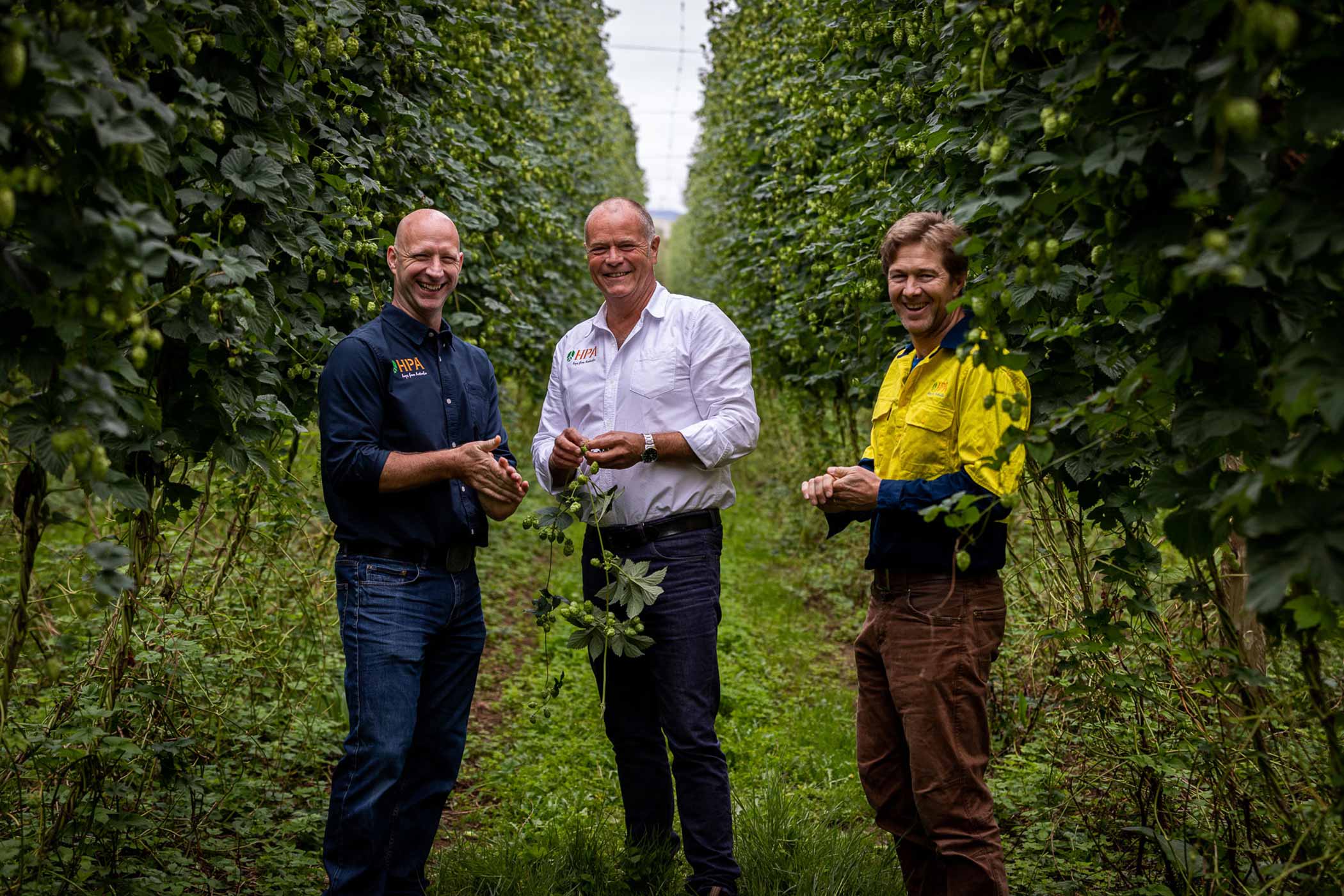Shop
From Spuds to Suds: Idaho’s Hop Growing Story
Did you know Idaho is the second-largest hop-growing area in the country?
Idaho grows fantastic hops. Curious? Be honest: Did you even know that the Gem State harvests the second-highest volume of hops in the country? Everyone associates Idaho with potatoes, but the state known for spuds has a serious love affair with suds.
According to the Hop Growers of America 2023 Statistical Report, Idaho harvested 8,645 acres of hops in 2023, accounting for 16% of the crops in the Pacific Northwest, surpassing Oregon’s 10%.
Anchored by a tight-knit group of growers (it’ll probably only take about twenty minutes to drive from one farthest farm to the other), Idaho’s hop industry has been a bit of a secret.
Until now.
Driven by unique new varieties like Idaho 7™, Idaho Gem Brand™, and a new experimental informally nicknamed “Pink” (EXP-158), plus standbys like Centennial and CTZ, Idaho hops should not be overlooked.
From spuds to suds, this is the story of Idaho’s hop-growing underdogs.
From Far-Away, Hot Pavements to Close, Cold Warehouses
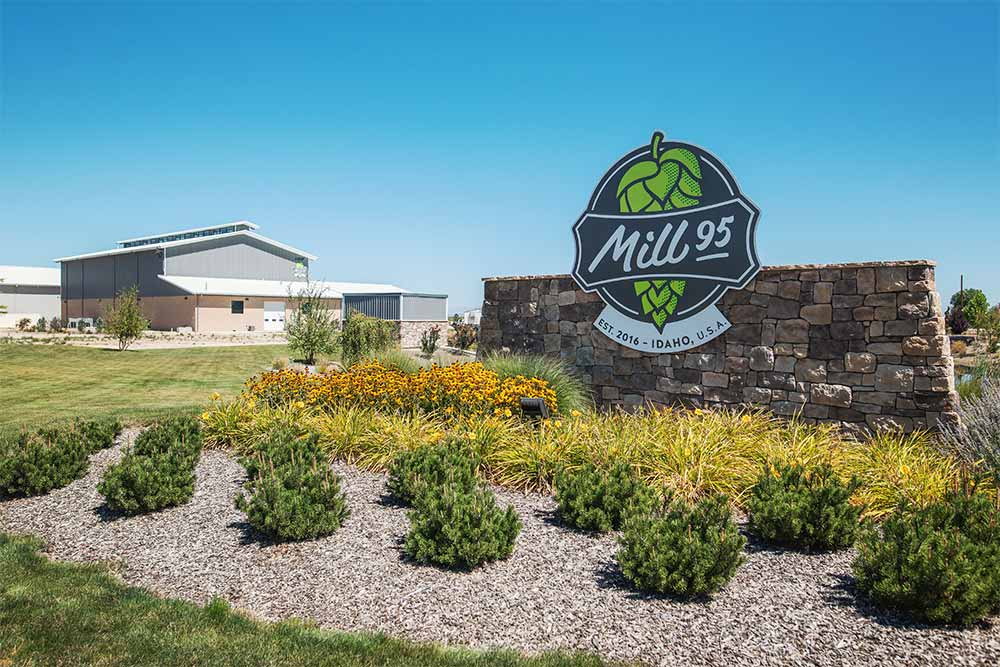
Photography courtesy of Mill 95
A fifth-generation Idahoan, Mill 95 Founder Jamie Scott grew up in a family of Idaho business owners.
“I’ve always been pretty enamored by hops,” says Scott, who started Idaho’s premier hop processing and pelletizing plant because as she looked at the Idaho hop industry, she saw a problem.
“Our Idaho growers were growing a fantastic product, but we were really sacrificing quality,” she explains, pointing out Idaho didn’t have a local processor like Mill 95.
According to Scott, Idaho growers had to send their hops to Yakima for processing and pelletizing.
“All of the hops were getting sent out of Idaho and weren’t being stored properly all the time,” she says. “Our Idaho hops were sacrificing quality by having to leave the state, travel far, and sometimes sit on the hot pavement.”
Mill 95 Operations Manager Carl Hoffman describes it as “going to the grocery store, buying groceries, and driving five hours with them in the back.”
No one wants to eat perishable products sitting in a hot car for hours, right?
Furthermore, once processors in Yakima pelletized the hops, they put them in local packaging. “[The hops] just came from a box that said it was from Yakima,” explains Hoffman.
Scott attributes these challenges to Idaho’s limited recognition in the hop-growing world.
“We had growers growing and some good local craft breweries, but again, without the whole ecosystem in place, we were getting overlooked and overshadowed by neighboring states.”
Those like Oregon and Washington, whose Yakima Valley has become a hotbed for breweries during the hop harvest.
“When you’re talking about hops with brewers out in the market, [Yakima] is the first thing that comes to their mind,” agrees Mill 95 Sales Manager Geoff Eiter.
Scott started Mill 95 to invest in Idaho’s agriculture and change the current state of “bine.”
Today, Mill 95 sits right in the thick of the action, eight minutes from the farthest farm.
“We can literally harvest hops right off the bine, get them into cold storage, cool them down, and process them,” she says. “We’ve built our brand on maintaining quality and excellent service above all else.”
And now they want to ensure that Idaho hop growers’ history reaches far and wide.
Because much like grapes in Napa Valley differ from those in Bordeaux, Idaho’s hops tell a story all their own.
The DNA of Idaho Hops
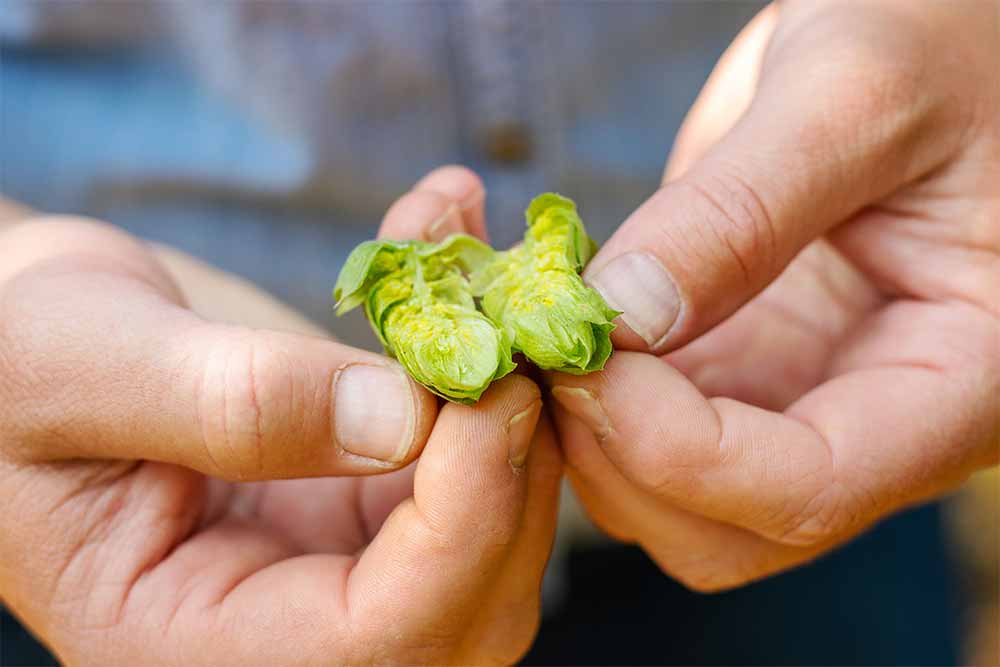
Photography courtesy of Mill 95
Understanding the brilliance of Idaho hops starts by looking at the DNA. Not just the DNA of what’s on the bine, but what’s in the hands of those who harvested them.
Like Scott comes from a line of business owners, many Idaho hop growers are part of multi-generational family farms.
“Many of them are fifth- or sixth-generation,” says Scott. “Our Idaho growers are very tenacious.”
They’ve had to be—constantly overshadowed by their glitzy growing neighbors to the Northwest.
Those like Diane Gooding, president of Gooding Farms and a sixth-generation owner along with her sisters.
Gooding Farms originally started in 1895 in Oregon’s Willamette Valley, but Gooding’s great-grandfather moved the farm to southern Idaho in the mid-1940s because “it has more conducive growing conditions, less disease pressure, and a more arid desert-type environment,” explains Gooding. “But with adequate irrigation and still at a fairly northern latitude.”
Just this year, Gooding says Idaho’s hot temperatures—with around thirty days over 100 degrees this summer—contributed to a crop with very intense aromas. During some pre-testing, “I was like, am I reading this right?” laughs Gooding. “The aroma intensity ratings were super high.”
In 2010, Gooding came back to run the farm with her dad, taking over fully almost a decade ago.
Ten or fifteen years ago, Gooding explained that Idaho was considered an alpha-growing region without specialization or oversight. “Kind of like your Walmart,” she says. But now, there has been a total turnover of generations, a more youthful crop of owners willing to experiment and diversify.
At its peak, Gooding Farm harvested 1,200 acres. Although they’re around the 600-700 mark now, Gooding says they’ve branched out, growing other crops such as sweet corn, beans, carrots, and onions.
And they’ve done the same on the hop side, where Gooding says they produce thirteen commercial varieties along with a few experimental ones in conjunction with the Hop Research Council and USDA public breeding program.
It’s a common approach with the younger generation of owners.
“We have a pretty good mix between alpha and aroma hops,” she says. “We’re trying to keep the business resilient and not put all our eggs in one basket.”
Their largest crop by acreage is CTZ, but she says, “Centennial has been a pretty nice star.” Although Centennial has been a historically finicky hop in the past, Gooding says it’s on track for a good yield this year. “We finally got the keys to the box on that one and nailed the timing and irrigation.”
High Quality Across Idaho Hops
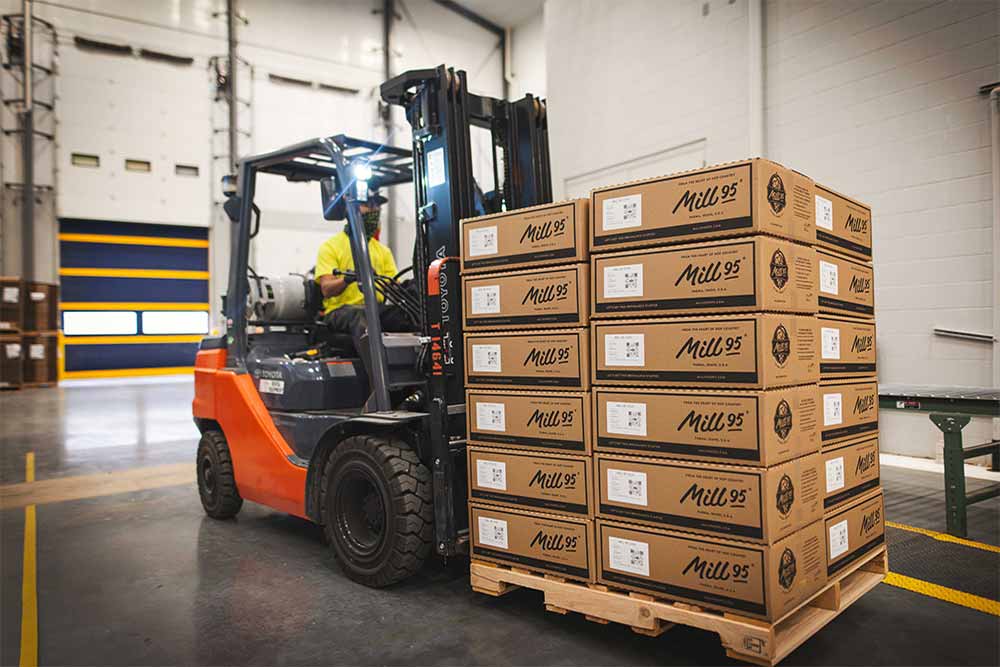
Photography courtesy of Mill 95
Scott started Mill 95 to preserve the quality of Idaho hops, like those from Gooding Farm and others; it’s one of the business’s core values.
“We’ve had such an explosion in the growth of the mid-sized brewer market, and we want them to think of the Mill synonymously with service and quality,” she explains. “Our team will pretty much do anything it takes to make a brewery happy.”
You can see that through every step of the process at the plant.
At Mill 95, Hoffman says the goal is to get hops from the field into state-of-the-art cold storage within fifteen to twenty minutes.
After freezing the bales, Hoffman’s team processes them, running three thousand to four thousand pounds an hour through the pellet mill before sending them right back into cold storage.
“We’re the small guy, so we try to do absolutely everything we can to make the best product possible,” Hoffman says.
Such as quick processing times and getting the hops at their peak right into the hands of brewers.
For example, “We received our lot of Centennial and ran it all yesterday,” says Hoffman. “We take a lot of pride in making the freshest product that you can possibly get.”
This year, Hoffman expects to process 1.2-1.3 million pounds of hops. Incredibly, he states matter-of-factly that they plan to finish by November. “We’ve run three million pounds through here and still [been] done before Thanksgiving,” he says proudly.
All the “blood, sweat, and beers,” as Mill 95 likes to say, goes into respecting the product their growers have harvested and their brewers will use.
That goes a long way for farms like Gooding, which also pride themselves on quality.
Gooding Farms has received numerous quality awards over the years, including placing second in the Cascade Cup, a prestigious yearly competition hosted by the Hop Quality Group that allows brewers all across the country to showcase their best Cascade hops.
The first farm to place from Idaho, Gooding is not content. “I haven’t won it yet, but you know there’s always next year,” she says with a smile, adding, “spoken like a true farmer.”
Gooding points out that the Idaho growers thrive off a “healthy competition for quality.”
“We all want to beat each other, right?” she says. “We’re like brothers and sisters, trying to one-up the other, but all that does is create better and better quality and better and better products.”
Gooding says it all boils down to “who has the best lawn, right!?”
Following that analogy, it seems that Idaho grass has found a place at the head of the class.
Idaho 7, Idaho Gem, and…Pink?
Recently, Idaho has gained some recognition in the industry for producing distinctive hop varieties like Idaho 7™ and Idaho Gem Brand™.
Often used in single-hop single-malt beers (SMaSH), Idaho 7™ stands out independently. “It’s a very unique hop that’s gained national attention,” says Eiter.
So much so that other states, such as Washington and Oregon, started growing the hop. “But, we’ve heard that the Idaho-grown [Idaho 7] is better for some reason,” Hoffman points out quickly. “We don’t know why, but certain varieties grow better in Idaho. It works fantastic here, so we’re pretty proud of [our hop growers].”
Idaho Gem Brand™ is an early-harvest hop, according to Gooding, who grows some on her farm.
“It’s really tropical, Juicy Fruit, sour cherry, Jolly Rancher,” she says when describing the flavor profile. “I’ve had raspberry jam as a descriptor before, so kind of some of that darker stone fruit or cane berry, and then, you know, more like mango sort of notes.”
Most recently, a farmer five minutes down the road from Mill 95 started growing an experimental variety EXP-158, which they’re calling Pink. According to Hoffman, “The number one [flavor] I’ve heard from Pink is bubblegum or grapefruit.”
With new varieties and a steady supply of top-quality hops coming out of Idaho, why aren’t more brewers visiting?
The Future in the Field of Idaho Dreams
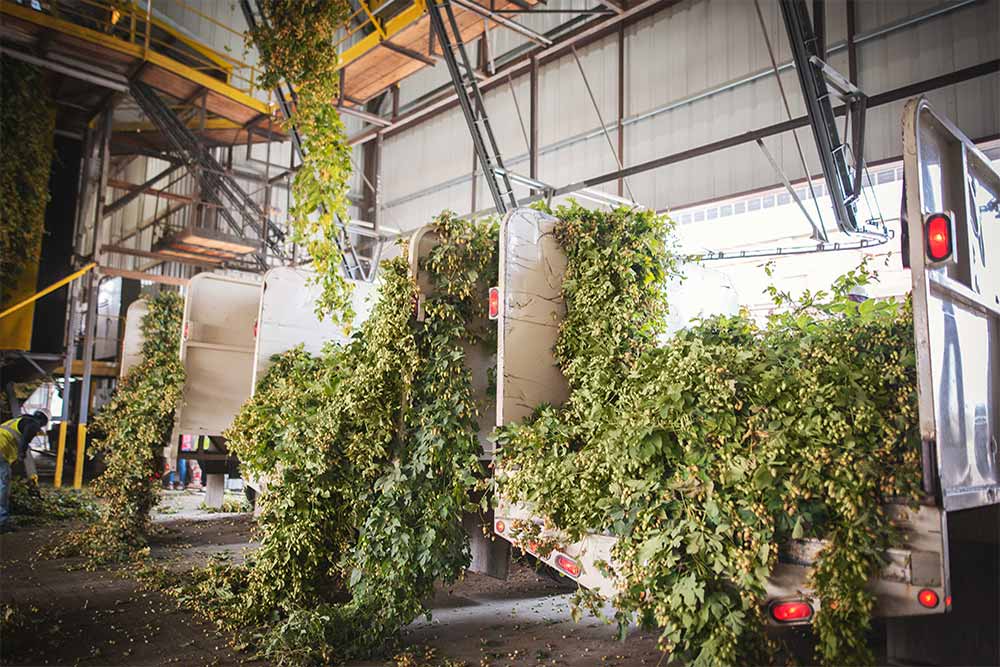
Photography courtesy of Mill 95
The fact is that when hop harvest rolls around, most brewers plan trips to Yakima.
That’s a challenge for Idaho hop growers.
Gooding recommends that brewers fly into Boise, visit the Idaho hop-growing region, drive the four and half hours over to Yakima, and fly out of Portland to hit all three major hop-growing areas.
But if she had it her way, industry folks would just come to Idaho. She cautions that “Yakima is so overwhelmed with brewer visits that it can be a little distracting. … There is a reason they call it Yak-Vegas!”
On the other hand, you’ll find a special, close-knit community in Idaho. Gooding explains that the further farms are only twenty minutes apart, whereas, in Yakima, you’re talking about an hour and a half drive from north to south.
“The tight-knit community here is pretty special in hops,” she says. “I’ve hosted a number of barbecues where literally every single grower brought their family.”
Scott describes hop harvest as “organized chaos … but everybody is ready to party when it’s over.”
Hoffman chimes in, adding, “And the harvest isn’t over until everybody’s done.”
Each farmer is always willing to help another, acting more like neighbors than rivals.
At Mill 95, getting brewers out to Idaho to experience this incredible, relatively unknown community is paramount.
“At the end of the day, they are our mouthpieces,” explains Eiter, who hopes breweries big and small that visit will go home saying, “Hey, you’re not going to believe what I saw up in Idaho.”
Despite the over 9,500 breweries operating in the country, the beer industry can feel fairly small. “When they start talking amongst themselves, they carry a lot of weight,” says Eiter, “and you want those brand ambassadors out there everywhere.”
To reach that goal, Mill 95 will host its third annual Camp 95 this September. The curated experience invites fourteen to sixteen brewers to come to the mill, participating in farm tours, educational workshops, culinary events, hop sensory, and more.
“We’ve tried to really curate a special experience so that people can get to know [one another], build relationships, get some education, and have a good time together,” says Scott.
Eiter praises Camp 95. “I’ve been to thousands of breweries throughout my time, and it’s very unique that a brewer gets to come out to do this, especially from some of the smaller breweries,” he explains.
Each grower has a story; the Idaho hop community just wants an opportunity to tell it.
“There’s a big push from farm to fork,” says Hoffman. “But we push from farm to pint.”
There’s a lot of time spent and a lot of care and pride that goes into everything in the Idaho hop industry.
Idaho hop growers may have been hidden before, but they are finally coming out of the shadows. With the secret of Idaho’s high-quality hops out in the open now, we expect that we won’t be calling Idaho hops underdogs for much longer.

